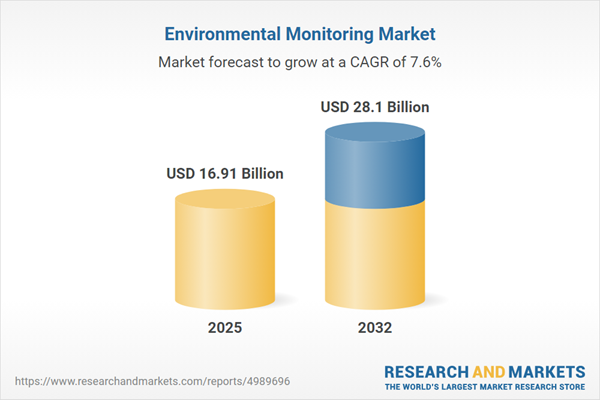Speak directly to the analyst to clarify any post sales queries you may have.
The Environmental Monitoring Market is evolving rapidly, driven by technology innovation, tightening regulations, and the increasing need for real-time data. Senior executives seeking clarity on strategic opportunities and challenges in this space will find actionable insights and a thorough analysis tailored to their decision-making requirements.
Market Snapshot: Environmental Monitoring Market Trends and Growth
The Environmental Monitoring Market grew from USD 15.70 billion in 2024 to USD 16.91 billion in 2025. This sector is projected to continue expanding at a compound annual growth rate (CAGR) of 7.55%, anticipating a value of USD 28.10 billion by 2032. These figures reflect the critical status of environmental monitoring as organizations respond to global sustainability targets, strict compliance demands, and the expansion of digital monitoring solutions. As industries prioritize resilience and transparency, advanced sensing and analytics are increasingly integrated throughout operations and regulatory frameworks.
Scope & Segmentation: Comprehensive Analysis Across Technologies, Parameters, Applications, and Regions
Environmental monitoring now encompasses a multi-faceted ecosystem straddling hardware, software, services, a wide range of monitored parameters, and end-user profiles. Key segmentation includes:
- Technology
- Hardware: Chromatography analyzers, spectrometry analyzers, gas sensors, and particle sensors
- Services: Consulting, installation, and maintenance
- Software: Data analytics and visualization tools
- Parameter
- Biological: Algae, bacteria
- Gas: Carbon dioxide, nitrogen oxides, volatile organic compounds
- Particulate Matter: PM10, PM2.5
- Physical: pH, temperature
- Application
- Air monitoring: Ambient and indoor
- Noise monitoring: Environmental and industrial
- Soil monitoring: Agricultural soil and contaminated soil
- Water monitoring: Drinking water and wastewater
- End User
- Commercial, industrial, municipal, research, and residential
- Regional Coverage
- Americas: United States, Canada, Mexico, Brazil, Argentina, Chile, Colombia, Peru
- Europe, Middle East & Africa: United Kingdom, Germany, France, Russia, Italy, Spain, Netherlands, Sweden, Poland, Switzerland, United Arab Emirates, Saudi Arabia, Qatar, Turkey, Israel, South Africa, Nigeria, Egypt, Kenya
- Asia-Pacific: China, India, Japan, Australia, South Korea, Indonesia, Thailand, Malaysia, Singapore, Taiwan
- Leading Companies
- Thermo Fisher Scientific Inc., Agilent Technologies, Inc., Danaher Corporation, Honeywell International Inc., Emerson Electric Co., AMETEK, Inc., Siemens AG, Teledyne Technologies Incorporated, Yokogawa Electric Corporation, HORIBA, Ltd.
Key Takeaways: Strategic Insights for the Environmental Monitoring Market
- Environmental monitoring has transitioned from basic compliance to a core strategic function, driven by rising stakeholder expectations around data transparency and accountability.
- Collaboration among government bodies, private enterprises, and universities is resulting in standardized protocols and the acceleration of interoperable digital networks, elevating sector-wide data quality and insights.
- Technological advances, such as sensor miniaturization and cloud-based analytics, are democratizing access to high-resolution monitoring, fostering innovation across commercial, industrial, and municipal domains.
- Segment differentiation is crucial; for example, operational requirements and compliance pressures vary significantly between municipal agencies, industrial facilities, and residential deployments.
- Competitive advantage is increasingly associated with integration—leading vendors blend precision hardware, intelligent software, and robust service frameworks to deliver scalable, resilient solutions.
Tariff Impact: Implications of 2025 United States Tariffs
Recent tariffs imposed by the United States in 2025 have caused significant supply chain and cost fluctuations for environmental monitoring providers. Duties on imported sensors and electronic components have resulted in increased prices, often passed down to end-users. These changes push organizations to diversify their supply bases, engage more with domestic suppliers, and optimize designs to absorb cost impacts. As a result, supply chain risk management has emerged as a high priority, spurring strategic realignments and operational adjustments.
Methodology & Data Sources
This report is based on a rigorous methodology combining extensive primary interviews with industry stakeholders and secondary research across technical literature, regulations, patents, and peer-reviewed publications. Field visits and product demonstrations ensured validation of findings, while multi-source triangulation and cross-referencing uphold the reliability of our analysis.
Why This Report Matters
- Offers comprehensive visibility into technologies, regional market dynamics, and competitive positioning tailored to senior-level decision-making.
- Delivers actionable strategies to navigate regulatory changes, supply disruptions, and emerging sustainability imperatives in the environmental monitoring sector.
- Supports planning for investment, product development, and partnership opportunities in a complex, high-growth environment.
Conclusion
This research delivers clarity on the dynamics shaping environmental monitoring, covering evolution in technology, standards, supply chains, and end-user priorities. Stakeholders can leverage these insights to anticipate industry shifts and craft effective, long-term strategies.
Additional Product Information:
- Purchase of this report includes 1 year online access with quarterly updates.
- This report can be updated on request. Please contact our Customer Experience team using the Ask a Question widget on our website.
Table of Contents
3. Executive Summary
4. Market Overview
7. Cumulative Impact of Artificial Intelligence 2025
Companies Mentioned
The companies profiled in this Environmental Monitoring market report include:- Thermo Fisher Scientific Inc.
- Agilent Technologies, Inc.
- Danaher Corporation
- Honeywell International Inc.
- Emerson Electric Co.
- AMETEK, Inc.
- Siemens AG
- Teledyne Technologies Incorporated
- Yokogawa Electric Corporation
- HORIBA, Ltd.
Table Information
| Report Attribute | Details |
|---|---|
| No. of Pages | 183 |
| Published | October 2025 |
| Forecast Period | 2025 - 2032 |
| Estimated Market Value ( USD | $ 16.91 Billion |
| Forecasted Market Value ( USD | $ 28.1 Billion |
| Compound Annual Growth Rate | 7.5% |
| Regions Covered | Global |
| No. of Companies Mentioned | 11 |









